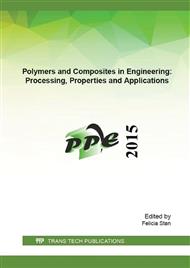p.49
p.57
p.63
p.71
p.80
p.86
p.91
p.97
p.104
Simplified Version of Polymer Rotational Molding Manufacturing Method
Abstract:
Rotational molding is a manufacturing method which supposes the rotation of the mold, during the solidification of the liquid phase material, so that finally a part having a hollow could be obtained. The method could be applied in manufacturing of metallic and nonmetallic parts. Usually, the equipment for rotational molding ensures slow speed rotating of the mold around two axes placed perpendicularly each other and this fact led to relatively complex equipment for achieving rotational molding. The capacity of the liquid material to entirely cover the internal walls of the mold depends essentially on the liquid material viscosity, on the rotation speed and on the movements applied to the mold. Simplified equipment including a single rotation movement could be materialized. In order to test such a solution, a preliminary experiment was designed and materialized, by using a device adapted on universal lathe. Thus, the objective of the research presented in the paper was to study if it is possible to achieve plastic parts made by rotational molding using a single rotation movement. A polyurethane resin obtained from two liquid components was used in order to obtain the liquid material that could be introduced in the mold. The research results proved the possibility to use simplified equipment for achieving a rotational molding process, at least in certain cases and with some technological limits.
Info:
Periodical:
Pages:
97-103
Citation:
Online since:
July 2016
Price:
Сopyright:
© 2016 Trans Tech Publications Ltd. All Rights Reserved
Share:
Citation:


